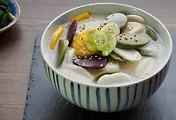One of the most popular seasonal fish found at seafood markets during winter is yellowtail (buri). Particularly from December to January, yellowtail reaches its peak in flavor and nutrition, making it a much-anticipated winter delicacy. Known for its rich taste and oily texture, yellowtail becomes even more flavorful during the cold months, reaching the pinnacle of its deliciousness. But why does yellowtail taste better in winter? Let’s explore the reasons behind this seasonal phenomenon.

The Physiological Features of Yellowtail and Its Winter Richness
Yellowtail, a migratory species in the family Carangidae, prefers warmer waters and migrates north during summer. As winter approaches, it moves south and increases its feeding activity to prepare for spawning. The primary reason winter yellowtail tastes better is its accumulation of fat during this time. To prepare for spawning, yellowtail stores energy in the form of fat, which reaches its peak during winter.
The rich, fatty flavor of yellowtail comes from its high-fat content, which includes healthy unsaturated fatty acids like DHA (docosahexaenoic acid) and EPA (eicosapentaenoic acid). These fats enhance the fish’s deep, savory taste and smooth texture. This natural trait is a result of the fish adapting to survive the cold winter and store enough energy for spring spawning. As a result, winter yellowtail offers a unique, rich flavor unmatched by other seasons.
Nutritional Value of Winter Yellowtail
Winter yellowtail is not just delicious; it’s also packed with nutrients, making it a highly nutritious fish. The abundance of DHA supports cardiovascular health and brain function, playing a crucial role in activating brain cells and aiding children’s cognitive development. Additionally, it is rich in vitamin D and vitamin E, which contribute to bone health and act as antioxidants to help combat aging.
As a red-fleshed fish, yellowtail is highly active and contains significant amounts of myoglobin, giving its flesh a reddish hue. This reflects the fish’s strong, developed muscles. Moreover, taurine in yellowtail helps improve liver function, reduce fatigue, and even support skin health. The omega-3 fatty acids in yellowtail help reduce triglyceride synthesis, prevent atherosclerosis, and minimize inflammation in the body.
Yellowtail Sizes and Their Flavor Differences: Small, Medium, and Large
Yellowtail varies in taste and texture depending on its size. Generally, fish under 3 kg are called small yellowtail, those between 3–5 kg are medium yellowtail, and those over 5 kg are large yellowtail. The larger the fish, the richer and more flavorful its taste and texture become. Additionally, fat is distributed differently depending on the size of the fish, offering unique culinary experiences with larger specimens.
The most sought-after parts of large yellowtail include the back meat, belly, collar, and fin meat, among others. Back meat is rich in fat yet maintains a clean taste, while belly meat boasts a buttery, rich flavor. Collar meat is prized for its savory taste and unique chewy texture, while belly cuts deliver a remarkable balance of fatty richness and umami. Fin meat, being a highly active part of the fish, is chewy and offers a distinct texture. Large yellowtail provides a variety of parts to savor, making it a favorite for gourmets.
Seasonality and Farming of Yellowtail
Yellowtail is a migratory species whose peak flavor coincides with its fat accumulation during winter. The prime season for yellowtail is from November to February, when its fat content and texture are at their finest. During summer, after spawning, the fish loses its fat, and its taste becomes less desirable. This is why winter is considered the best season to enjoy yellowtail.
Yellowtail can be divided into wild-caught and farmed varieties. Wild yellowtail is typically caught off the coasts of the East Sea and Jeju Island, while farmed yellowtail is raised in marine cages in regions like Tongyeong and along the East Coast. In recent years, warmer water temperatures have allowed yellowtail to migrate further north, increasing catch quantities. Farmed yellowtail are often raised to 5–7 kg and then grown to over 10 kg before being sold as premium-grade fish.
Yellowtail vs. Amberjack
A fish often compared to yellowtail is amberjack (hiramasa). While similar in appearance, they differ in flavor and seasonal preference. Amberjack is at its best in summer, offering a clean, light taste, while yellowtail excels in winter with its rich, fatty flavor. A popular saying in Japan and Korea, “Yellowtail in winter, amberjack in summer,” highlights their seasonal differences. For the best culinary experience, it’s recommended to enjoy these fish during their respective peak seasons.
Cooking with Yellowtail
Yellowtail is versatile and can be enjoyed in a variety of ways. It is often eaten raw as sashimi, but it’s also excellent grilled or in stews. Large yellowtail, in particular, offers diverse cuts that appeal to gourmet diners. The head can be grilled with salt or steamed with aged kimchi for a rich, savory taste, while the bones make for a hearty, milky soup when boiled.
Conclusion
Winter yellowtail, with its rich, fatty flavor and exceptional nutritional value, is a beloved seasonal fish. Its deliciousness comes from the fat it accumulates to prepare for spawning, making it flavorful and savory. Loaded with DHA, vitamin D, and vitamin E, it also provides numerous health benefits. Whether small, medium, or large, yellowtail offers a range of unique textures and tastes, with large yellowtail being especially prized for its gourmet appeal. This winter, treat yourself to the full-bodied flavor and health benefits of yellowtail and enjoy the best of what the season has to offer!
'생활백서' 카테고리의 다른 글
| 한 살 더, 설날에 떡국을 먹는 이유에 대해 알아보자. (15) | 2025.01.27 |
|---|---|
| Exploring the True Value of Mint. (63) | 2025.01.27 |
| Protecting Your Body from Cold Waves: How to Prepare for Cold-Related Illnesses. (51) | 2025.01.27 |
| 섬세해질 필요, 침묵의 장기 췌장이 보내는 건강 이상신호를 알아차려보자. (64) | 2025.01.27 |
| Understanding the Causes of Separation Anxiety. (63) | 2025.01.27 |



